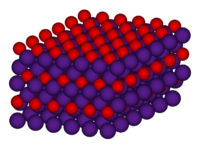Caesium oxide
| Caesium oxide[1][2] | |
|---|---|
 | |
| IUPAC name Caesium oxide | |
| Other names Cesium oxide (US) | |
| Identifiers | |
| CAS number | 20281-00-9 |
| PubChem | 9903865 |
| ChemSpider | 8079519 |
| EC-number | 243-679-0 |
| Jmol-3D images | {{#if:[Cs+].[Cs+].[O-2]|Image 1 |
| |
| |
| Properties | |
| Molecular formula | Cs2O |
| Molar mass | 281.81 g/mol |
| Appearance | yellow-orange solid |
| Density | 4.65 g/cm3, solid |
| Melting point | 490 °C (under N2) |
| Solubility in water | reacts |
| Structure | |
| Crystal structure | anti-CdCl2 (hexagonal) |
| Thermochemistry | |
| Std enthalpy of formation ΔfH |
-345.8 kJ/mol |
| Standard molar entropy S |
146.9 J K-1 mol-1 |
| Specific heat capacity, C | 76.0 J K-1 mol-1 |
| Hazards | |
| EU Index | not listed |
| Flash point | non-flammable |
| Related compounds | |
| Other anions | Caesium hydroxide |
| Other cations | Lithium oxide Sodium oxide Potassium oxide Rubidium oxide |
| Except where noted otherwise, data are given for materials in their standard state (at 25 °C (77 °F), 100 kPa) | |
| Infobox references | |
Caesium oxide (IUPAC name) or cesium oxide describes inorganic compounds composed of caesium and oxygen. The following binary (containing only Cs and O) oxides of caesium are known: Cs11O3, Cs4O, Cs7O, and Cs2O.[3] Both the oxide and suboxides are brightly coloured. The species Cs2O forms yellow-orange hexagonal crystals.[1]
Uses
Caesium oxide is used in photocathodes to detect infrared signals in devices such as image intensifiers, vacuum photodiodes, photomultipliers, and TV camera tubes[4] L. R. Koller described the first modern photoemissive surface in 1929–30 as a layer of caesium on a layer of caesium oxide on a layer of silver.[5] It is a good electron emitter; however, its high vapor pressure limits its usefulness.[6]
Reactions
Elemental magnesium reduces caesium oxide to elemental caesium, forming magnesium oxide as a side-product:[7][8]
- Cs2O + Mg → 2Cs + MgO
Cs2O is hygroscopic, forming the corrosive CsOH on contact with water.
References
- ↑ 1.0 1.1 Lide, David R., ed. (2006). CRC Handbook of Chemistry and Physics (87th ed.). Boca Raton, FL: CRC Press. pp. 451, 514. ISBN 0-8493-0487-3..
- ↑ Greenwood, Norman N.; Earnshaw, Alan (1984). Chemistry of the Elements. Oxford: Pergamon Press. pp. 97–100. ISBN 0-08-022057-6..
- ↑ Simon, A. (1997), "Group 1 and 2 Suboxides and Subnitrides — Metals with Atomic Size Holes and Tunnels", Coord. Chem. Rev. 163: 253–270, doi:10.1016/S0010-8545(97)00013-1.
- ↑ Capper, Peter; Elliott, C. T. (2000), Infrared Detectors and Emitters, Springer, p. 14, ISBN 978-0-7923-7206-6
- ↑ Busch, Kenneth W.; Busch, Marianna A. (1990), Multielement Detection Systems for Spectrochemical Analysis, Wiley-Interscience, p. 12, ISBN 978-0-471-81974-5
- ↑ Boolchand, Punit, ed. (2000), Insulating and Semiconducting Glasses, World Scientific, p. 855, ISBN 978-981-02-3673-1
- ↑ Turner, Jr., Francis M., ed. (1920), The Condensed Chemical Dictionary, New York: Chemical Catalog Co., p. 121
- ↑ Arora, M.G. (1997), S-Block Elements, New Delhi: Anmol Publications, p. 13, ISBN 978-81-7488-562-3
| |||||